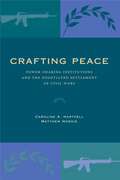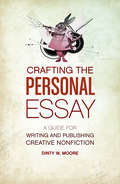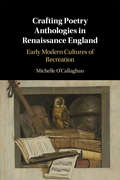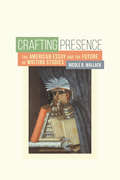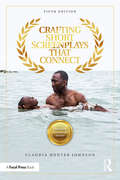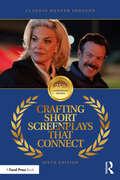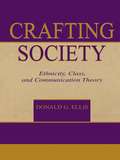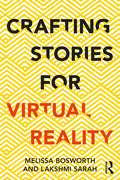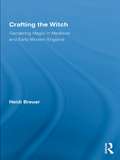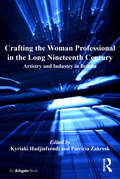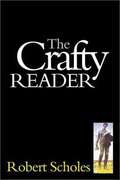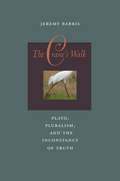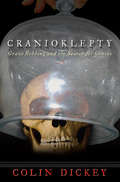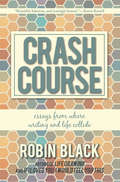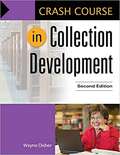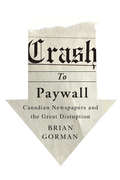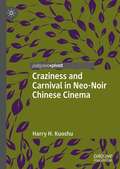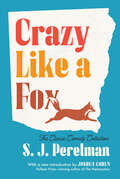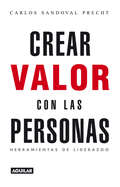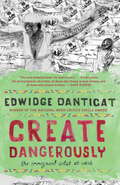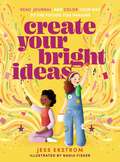- Table View
- List View
Crafting Peace: Power-Sharing Institutions and the Negotiated Settlement of Civil Wars
by Caroline A. Hartzell Matthew HoddieThe recent efforts to reach a settlement of the enduring and tragic conflict in Darfur demonstrate how important it is to understand what factors contribute most to the success of such efforts. In this book, Caroline Hartzell and Matthew Hoddie review data from all negotiated civil war settlements between 1945 and 1999 in order to identify these factors.What they find is that settlements are more likely to produce an enduring peace if they involve construction of a diversity of power-sharing and power-dividing arrangements between former adversaries. The strongest negotiated settlements prove to be those in which former rivals agree to share or divide state power across its economic, military, political, and territorial dimensions.This finding is a significant addition to the existing literature, which tends to focus more on the role that third parties play in mediating and enforcing agreements. Beyond the quantitative analyses, the authors include a chapter comparing contrasting cases of successful and unsuccessful settlements in the Philippines and Angola, respectively.
Crafting The Personal Essay: A Guide for Writing and Publishing Creative Non-Fiction
by Dinty W. MooreAward winning essayist Scott Russell Sanders once compared the art of essay writing to "the pursuit of mental rabbits"#151;a rambling through thickets of thought in search of some brief glimmer of fuzzy truth. While some people persist in the belief that essays are stuffy and antiquated, the truth is that the personal essay is an ever-changing creative medium that provides an ideal vehicle for satisfying the human urge to document truths as we experience them and share them with others#151;to capture a bit of life on paper. Crafting the Personal Essayis designed to help you explore the flexibility and power of the personal essay in your own writing. This hands-on, creativity-expanding guide will help you infuse your nonfiction with honesty, personality, and energy. You'll discover: An exploration of the basics of essay writing Ways to step back and scrutinize your experiences in order to separate out what may be fresh, powerful, surprising or fascinating to a reader How to move past private "journaling" and write for an audience How to write eight different types of essays including memoir, travel, humor, and nature essays among others Instruction for revision and strategies for getting published Brimming with helpful examples, exercises, and sample essays, this indispensable guide will help your personal essays transcend the merely private to become powerfully universal.
Crafting Poetry Anthologies in Renaissance England: Early Modern Cultures of Recreation
by Michelle O'CallaghanThe printed poetry anthologies first produced in sixteenth-century England have long been understood as instrumental in shaping the history of English poetry. This book offers a fresh approach to this history by turning attention to the recreative properties of these books, both in the sense of making again, of crafting and recrafting, and of poetry as a pleasurable pastime. The model of materiality employed extends from books-as-artefacts to their embodiedness - their crafted, performative, and expressive capacities. Publishers invariably advertised the recreational uses of anthologies, locating these books in early modern performance cultures in which poetry was read, silently and in company, sometimes set to music, and re-crafted into other forms. Engaging with studies of material cultures, including work on craft, households, and soundscapes, Crafting Poetry Anthologies argues for a domestic Renaissance in which anthologies travelled across social classes, shaping recreational cultures that incorporated men and women in literary culture.
Crafting Presence: The American Essay and the Future of Writing Studies
by Nicole B. WallackEssays are central to students’ and teachers’ development as thinkers in their fields. In Crafting Presence, Nicole B. Wallack develops an approach to teaching writing with the literary essay that holds promise for writing students, as well as for achieving a sense of common purpose currently lacking among professionals in composition, creative writing, and literature. Wallack analyzes examples drawn primarily from volumes of The Best American Essays to illuminate the most important quality of the essay as a literary form: the writer’s “presence.” She demonstrates how accounting for presence provides a flexible and rigorous heuristic for reading the contexts, formal elements, and purposes of essays. Such readings can help students learn writing principles, practices, and skills for crafting myriad presences rather than a single voice. Crafting Presence holds serious implications for writing pedagogy by providing new methods to help teachers and students become more insightful and confident readers and writers of essays. At a time when liberal arts education faces significant challenges, this important contribution to literary studies, composition, and creative writing shows how an essay-centered curriculum empowers students to show up in the world as public thinkers who must shape the “knowledge economy” of the twenty-first century.
Crafting Short Screenplays That Connect
by Claudia Hunter JohnsonCrafting Short Screenplays That Connect, Fifth Edition, stands alone among screenwriting books by emphasizing that human connection, though often overlooked, is as essential to writing effective screenplays as conflict. This ground-breaking book will show you how to advance and deepen your screenwriting skills, increasing your ability to write richer, more resonant short screenplays that will connect with your audience. Award-winning writer and director Claudia Hunter Johnson teaches you the all-important basics of dramatic technique and guides you through the challenging craft of writing short screenplays with carefully focused exercises of increasing length and complexity. In completing these exercises and applying Johnson’s techniques and insights to your own work, you will learn how to think more deeply about the screenwriter’s purpose, craft effective patterns of human change, and strengthen your storytelling skills. This 20th Anniversary Edition features 11 short screenplays, including Academy Award winning Barry Jenkins' (Moonlight, If Beale Street Could Talk) luminous short film, My Josephine, and an accompanying companion website that features the completed films and additional screenplay examples. The book has also been expanded and updated to include two new award-winning screenplays Killer Kart and The Great Wall of Vicky Lynn. and a brand-new chapter exploring the use of genre in the short film. An absolute must-have resource for students of screenwriting.
Crafting Short Screenplays That Connect
by Claudia Hunter JohnsonCrafting Short Screenplays That Connect, Sixth Edition, stands alone among screenwriting books by emphasizing that human connection, though often overlooked, is as essential to writing effective screenplays as conflict.Award-winning writer and director Claudia Hunter Johnson teaches you the all-important basics of dramatic technique and guides you through the challenging craft of writing short screenplays with carefully focused exercises of increasing length and complexity. In completing these exercises and applying Johnson’s techniques and insights to your own work, you will learn how to think more deeply about the screenwriter’s purpose, craft effective patterns of human change, and strengthen your storytelling skills. This 25th Anniversary Edition features 11 short screenplays, including Academy Award winning Barry Jenkins’ (Moonlight, If Beale Street Could Talk) luminous short film, My Josephine (now in the Criterion Collection), and an accompanying companion website that features the completed films and additional screenplay examples. The book has also been updated and expanded to include more excerpts from leading films and TV series as well as collaboration exercises and invaluable guidance about giving and receiving effective feedback.This ground-breaking book will show you how to advance and deepen your screenwriting skills, increasing your ability to write richer, more resonant short screenplays that will connect with your audience. It remains an absolute must have resource for students of screenwriting.
Crafting Society: Ethnicity, Class, and Communication Theory (Routledge Communication Series)
by Donald G. EllisThe study of communication, language, and discourse is at once simple, elegant, and complex. Each of these areas is informed by "micro" subjective experiences of individuals and the "macro" processes of a culture. Communication itself is thoroughly modern yet it seeks anchorage in the traditions of the humanities and social sciences. All of this creates a significant challenge. In this monograph, Ellis considers the study of communication as he discusses three key issues in communication theory: (1) the growing emphasis on meaning, (2) the importance of a mediated culture, and (3) the links between micro communication activities and macro social categories such as ethnicity and social class. In response to these three issues, this book deals with the way people use language and communication to construct their world; this world is not constructed purely but is influenced by attitudes, ideologies, and biases. In the modern world the medium of communication has an impact on consciousness and society, and Ellis shows how the media are responsible for some of the fault lines in society. The book also explores principles of medium theory and documents the impact of media on psychological and sociological phenomena. Finally, work of Goffman, Giddens, and Randall Collins is extended to show how micro communication behaviors are implicated in and by social conditions. ADDITIONAL COPY FOR MAILER Expanded features: * The chapters work out a logic connecting real communication patterns with the broad principles upon which societies are explored. Thus the title "Crafting" Society--the crafting is purposefully active to indicate the dynamic processes involved in creating what we call society. Society and culture have their roots and empirical bases in communication; that is, in the daily struggles of interaction. * Two chapters on two of the most important and controversial issues of the day--ethnicity and class. These two chapters are clear illustrations of the new theoretical principles discussed throughout the book. * A chapter on social class is very unique for a book devoted to communication processes. Communication theorists do not usually write about class, even though it is a highly symbolic process and rooted in communication patterns. Class is a difficult concept in America since so few people, other than sociologists, care to talk about it. * A chapter on medium theory takes the bold step of experimenting a little by summarizing basic causal statements and propositions. This device underscores the goal of a theory which is to come to grips with testable statements. The focus is on medium theory and how the media influence consciousness and social structure. * A unique chapter takes up the issue of how communication processes are constitutive of social structures. It draws on work by Giddens and others to return to a concept of structure based on actions that produce and reproduce structure.
Crafting Stories for Virtual Reality
by Melissa Bosworth Lakshmi SarahWe are witnessing a revolution in storytelling. Publications all over the world are increasingly using immersive storytelling—virtual reality, augmented reality and mixed reality—to tell compelling stories. The aim of this book is to distill the lessons learned thus far into a useful guide for reporters, filmmakers and writers interested in telling stories in this emerging medium. Examining ground-breaking work across industries, this text explains, in practical terms, how storytellers can create their own powerful immersive experiences as new media and platforms emerge.
Crafting Strategy: Embodied Metaphors in Practice
by Loizos Heracleous Claus D. JacobsThe rationalist approach to strategizing emphasizes analytical and convergent thinking. Without denying the importance of this approach, this book argues that strategists must learn to complement it with a more creative approach to strategizing that emphasizes synthetic and divergent ways of thinking. The theoretical underpinnings of this approach include embodied realism, interpretivism, practice theory, theory of play, design thinking, as well as discursive approaches such as metaphorical analysis, narrative analysis, dialogical analysis and hermeneutics. The book includes in-depth discussions of these theories and shows how they can be put into practice by presenting detailed analyses of embodied metaphors built by groups of agents with step-by-step explanations of how this process can be implemented and facilitated. The link between theory and practice is further supported by the inclusion of several vignettes that describe how this approach has been successfully employed in a number of organizations, including BASF and UNICEF.
Crafting the Witch: Gendering Magic in Medieval and Early Modern England (Studies in Medieval History and Culture)
by Heidi BreuerThis book analyzes the gendered transformation of magical figures occurring in Arthurian romance in England from the twelfth to the sixteenth centuries. In the earlier texts, magic is predominantly a masculine pursuit, garnering its user prestige and power, but in the later texts, magic becomes a primarily feminine activity, one that marks its user as wicked and heretical. This project explores both the literary and the social motivations for this transformation, seeking an answer to the question, 'why did the witch become wicked?' Heidi Breuer traverses both the medieval and early modern periods and considers the way in which the representation of literary witches interacted with the culture at large, ultimately arguing that a series of economic crises in the fourteenth century created a labour shortage met by women. As women moved into the previously male-dominated economy, literary backlash came in the form of the witch, and social backlash followed soon after in the form of Renaissance witch-hunting. The witch figure serves a similar function in modern American culture because late-industrial capitalism challenges gender conventions in similar ways as the economic crises of the medieval period.
Crafting the Woman Professional in the Long Nineteenth Century: Artistry and Industry in Britain
by Kyriaki Hadjiafxendi Patricia ZakreskiOver the course of the nineteenth century, women in Britain participated in diverse and prolific forms of artistic labour. As they created objects and commodities that blurred the boundaries between domestic and fine art production, they crafted subjectivities for themselves as creative workers. By bringing together work by scholars of literature, painting, music, craft and the plastic arts, this collection argues that the constructed and contested nature of the female artistic professional was a notable aspect of debates about aesthetic value and the impact of industrial technologies. All the essays in this volume set up a productive inter-art dialogue that complicates conventional binary divisions such as amateur and professional, public and private, artistry and industry in order to provide a more nuanced understanding of the relationship between gender, artistic labour and creativity in the period. Ultimately, how women faced the pragmatics of their own creative labour as they pursued vocations, trades and professions in the literary marketplace and related art-industries reveals the different ideological positions surrounding the transition of women from industrious amateurism to professional artistry.
Crafty TV Writing: Thinking Inside the Box
by Alex EpsteinA professional TV writer's real-world guide to getting paid to write great television"No need for me to ever write a book on TV writing. Alex Epstein has covered it all . . . along with a few things I wouldn't have thought of. Save yourself five years of rookie mistakes. Crafty TV Writing and talent are pretty much all you'll need to make it."—Ken Levine, writer/producer, MASH, Cheers, Frasier, The Simpsons, Wings, BeckerEveryone watches television, and everyone has an opinion on what makes good TV. But, as Alex Epstein shows in this invaluable guide, writing for television is a highly specific craft that requires knowledge, skill, and more than a few insider's tricks.Epstein, a veteran TV writer and show creator himself, provides essential knowledge about the entire process of television writing, both for beginners and for professionals who want to go to the next level. Crafty TV Writing explains how to decode the hidden structure of a TV series. It describes the best ways to generate a hook, write an episode, create characters the audience will never tire of, construct entertaining dialogue, and use humor. It shows how to navigate the tough but rewarding television industry, from writing your first "spec" script, to getting hired to work on a show, to surviving—even thriving—if you get fired. And it illuminates how television writers think about the shows they're writing, whether they're working in comedy, drama, or "reality."Fresh, funny, and informed, Crafty TV Writing is the essential guide to writing for and flourishing in the world of television.
The Crane's Walk: Plato, Pluralism, and the Inconstancy of Truth
by Jeremy BarrisIn The Crane's Walk, Jeremy Barris seeks to show that we can conceive and live with a pluralism of standpoints with conflicting standards for truth--with the truth of each being entirely unaffected by the truth of the others. He argues that Plato's work expresses this kind of pluralism, and that this pluralism is important in its own right, whether or not we agree about what Plato's standpoint is.The longest tradition of Plato scholarship identifies crucial faults in Plato's theory of Ideas. Barris argues that Plato deliberately displayed those faults, because he wanted to demonstrate that basic kinds of error or illogic have dimensions that are crucial to the establishing of truth. These dimensions legitimate a paradoxical coordination of logically incompatible conceptions of truth. Connecting this idea with emerging currents of Plato scholarship, he emphasizes, in addition to the dialogues' arguments, the importance of their nonargumentative features, including drama, myths, fictions, anecdotes, and humor. These unanalyzed nonargumentative features function rigorously, as a lever with which to examine the enterprise of rational argument itself, without presupposing its standards or illegitimately assimilating any position to the standards of another.Today, communities are torn apart by conflicts within and between a host of different pluralist and absolutist commitments. The possibility developed in this book-a coordination of absolute and relative truth that allows an understanding of some relativist and some absolutist positions as being fully legitimate and as capable of existing in a relation to their opposites-may contribute to perspectives for resolving these conflicts.
Cranioklepty
by Colin DickeyThe after-death stories of Franz Joseph Haydn, Ludwig Beethoven, Swedenborg, Sir Thomas Browne and many others have never before been told in such detail and vividness.Fully illustrated with some surprising images, this is a fascinating and authoritative history of ideas carried along on the guilty pleasures of an anthology of real-after-life gothic tales.Beginning dramatically with the opening of Haydn's grave in October 1820, cranioklepty takes us on an extraordinary history of a peculiar kind of obsession. The desire to own the skulls of the famous, for study, for sale, for public (and private) display, seems to be instinctual and irresistible in some people. The rise of phrenology at the beginning of the 19th century only fed that fascination with the belief that genius leaves its mark on the very shape of the head.
Crash Course: Essays From Where Writing and Life Collide
by Robin BlackRobin Black's path through loss and survival delivered her to the writer's life. Agoraphobia, the challenges of parenting a child with special needs, and the legacy of a formidable father all shaped that journey. In these deeply personal and instructive essays, the author of the internationally acclaimed If I loved you, I would tell you this and Life Drawing explores the making of art through the experiences of building a life. Engaging, challenging, and moving, Crash Course is full of insight into how to write-and why.From "Autumn, 1972, A Moment at Which I Became a Writer":I sense, even now, the reverberations of a kind of shattering of my foundation and a quick rebuild, a change at a molecular level of who I understood myself to be. No longer someone who could look at another person without wondering what their life was like, but someone with a new curiosity about what people's stories might actually be.Robin Black is the author of the story collection, If I loved you, I would tell you this and the novel Life Drawing, both critically acclaimed, and both published in multiple languages. She has developed a loyal, enthusiastic following for her essays on life and writing, online and in such publications as the New York Times, the Chicago Tribune, and O Magazine. She lives with her husband in Philadelphia, Pennsylvania, where the house is always open for their three grown children.
Crash Course in Collection Development (Crash Course series)
by Wayne DisherThis professional volume covers all aspects of collection development and management in the public library, from gathering statistics to design a collection that meets community needs, to selecting materials, managing vendor relations, understanding the publishing industry, and handling complaints. Author Wayne Disher provides public librarians―especially those without the benefit of academic training―access to the tools needed for their success and ensure their collections are beneficial to the public they serve. <p><p> The second edition features two new chapters on digital curation and cooperative collection development. Additional updates include helpful information on infographics, more budgeting formulas, and a section on core collections, as well as content covering eBooks, electronic storage, and digital rights management. Chapters discuss subjects such as marketing the collection to patrons, book repair, and handling censorship issues when collections are challenged.
Crash to Paywall
by Brian GormanIn 2014, when Postmedia acquired Quebecor's Sun Media newspaper and online assets, there was a sense that the recent history of newspapers was repeating itself not as comedy or tragedy, but as eulogy. Crash to Paywall shows that while the newspaper business was weakened by decreases in advertising revenues and circulation, much of its problems stem from self-inflicted damage and business practices dating back to the 1970s. Brian Gorman explores the Canadian newspaper industry crisis and the relationship between the news media and the public. He challenges both the popular mantra that a "perfect storm" of unforeseen circumstances blindsided a declining industry and the narrative that readers were abandoning newspapers, causing advertisers to turn away from "dying" media. Gorman argues that observers had been warning for decades that the business was creating its own problems by acquiring ever-larger debt and shareholder obligations while steadily cutting back on journalists' resources. Finally, by providing journalism for free online, newspaper companies devalued their most important resource and impaired their profitable print products. With dozens of interviews conducted with leading Canadian journalists and editors, Crash to Paywall brings to light the many misconceptions, generalizations, omissions, and highly suspect conclusions about the present state of newspapers and their future.
Crash to Paywall: Canadian Newspapers and the Great Disruption
by Brian GormanIn 2014, when Postmedia acquired Quebecor's Sun Media newspaper and online assets, there was a sense that the recent history of newspapers was repeating itself not as comedy or tragedy, but as eulogy. Crash to Paywall shows that while the newspaper business was weakened by decreases in advertising revenues and circulation, much of its problems stem from self-inflicted damage and business practices dating back to the 1970s. Brian Gorman explores the Canadian newspaper industry crisis and the relationship between the news media and the public. He challenges both the popular mantra that a "perfect storm" of unforeseen circumstances blindsided a declining industry and the narrative that readers were abandoning newspapers, causing advertisers to turn away from "dying" media. Gorman argues that observers had been warning for decades that the business was creating its own problems by acquiring ever-larger debt and shareholder obligations while steadily cutting back on journalists' resources. Finally, by providing journalism for free online, newspaper companies devalued their most important resource and impaired their profitable print products. With dozens of interviews conducted with leading Canadian journalists and editors, Crash to Paywall brings to light the many misconceptions, generalizations, omissions, and highly suspect conclusions about the present state of newspapers and their future.
Craziness and Carnival in Neo-Noir Chinese Cinema (Chinese Literature and Culture in the World)
by Harry H. KuoshuCraziness and Carnival in Neo-Noir Chinese Cinema offers an in-depth discussion of the “stone phenomenon” in Chinese film production and cinematic discourses triggered by the extraordinary success of the 2006 low-budget film, Crazy Stone. Surveying the nuanced implications of the film noir genre, Harry Kuoshu argues that global neo noir maintains a mediascape of references, borrowings, and re-workings and explores various social and cultural issues that constitute this Chinese episode of neo noir. Combining literary explorations of carnival, postmodernism, and post-socialism, Kuoshu advocates for neo noir as a cultural phenomenon that connects filmmakers, film critics, and film audiences rather than an industrial genre.
Crazy Brave: A Memoir
by Joy HarjoIn this transcendent memoir, grounded in tribal myth and ancestry, music and poetry, Joy Harjo, one of our leading Native American voices, details her journey to becoming a poet. Born in Oklahoma, the end place of the Trail of Tears, Harjo grew up learning to dodge an abusive stepfather by finding shelter in her imagination, a deep spiritual life, and connection with the natural world. She attended an Indian arts boarding school, where she nourished an appreciation for painting, music, and poetry; gave birth while still a teenager; and struggled on her own as a single mother, eventually finding her poetic voice. Narrating the complexities of betrayal and love, Crazy Brave is a memoir about family and the breaking apart necessary in finding a voice. Harjo's tale of a hardscrabble youth, young adulthood, and transformation into an award-winning poet and musician is haunting, unique, and visionary.
Crazy Like a Fox: The Classic Comedy Collection
by S. J. PerelmanA beloved classic returns: S. J. Perelman's own selection of the very best of his hilarious stories and sketchesPulitzer Prize–winning author Joshua Cohen (The Netanyahus) reintroduces America's zaniest humorist to a new generation of readersWhen asked about himself the writer Sidney Joseph Perelman once quipped, "before they made him, they broke the mold." Nowhere is S. J. Perelman's one-of-a-kind, madcap sensibility—his gift for wordplay, witticism, spoofery, and sheer nonsense—on better display than in his classic collection Crazy Like a Fox, here restored to print for the first time in decades.In a playful, loving tribute to the funny man, novelist Joshua Cohen—also an erudite wordsmith and punster—introduces Perelman&’s sui generis comic pieces to a new generation of readers, certain to fall in love with the writer whom The New York Times once noted for his ability &“to transform the common cliché or figure of speech into an exploding cigar.&” Included here are such beloved classics as:the Joycean virtuoso performance &“Scenario&”&“A Farewell to Omsk,&” Perelman's hilarious homage to Dostoevskyand &“Farewell, My Lovely Appetizer," his side-splitting send-up of the hardboiled detective fiction of Raymond ChandlerHere is Perelman's own selection of the very best of his inimitable humor, restored to print for the first time in decades.
Crear valor con las personas
by Carlos SandovalCrear valor con las personas aborda el tema del liderazgo desde cinco aspectos claves, que son fundamentales a la hora de construirnos como líderes. Crear valor con las personas aborda el tema del liderazgo desde cinco aspectos claves, son fundamentales a la hora de construirnos como líderes: la personalidad, el ciclo efectivo, lo facilitador, la transformación y el cambio. Usando ejemplos didácticos, casos particulares y ejercicios, Carlos Sandoval Precht, asume desde la primera página que el éxito de una empresa, sea ésta un negocio internacional o una banda de rock, se define por la personalidad de su líder. Y ser líder no es saber mandar ni ser simpático o pesado, sino saber darle valor a cada persona que trabaja con nosotros.
Create Dangerously: The Immigrant Artist at Work (Vintage Contemporaries)
by Edwidge DanticatA New York Times Notable BookA Miami Herald Best Book of the YearIn this deeply personal book, the celebrated Haitian-American writer Edwidge Danticat reflects on art and exile. Inspired by Albert Camus and adapted from her own lectures for Princeton University's Toni Morrison Lecture Series, here Danticat tells stories of artists who create despite (or because of) the horrors that drove them from their homelands. Combining memoir and essay, these moving and eloquent pieces examine what it means to be an artist from a country in crisis.From the Trade Paperback edition.
Create Your Bright Ideas: Read, Journal, and Color Your Way to the Future You Imagine
by Jess EkstromThis interactive book for energetic, creatively minded 8- to 12-year-olds from entrepreneur Jess Ekstrom uses inspiring stories, journaling prompts, coloring pages, and creative ideas to show kids that if they want something to be different in the world, they can do something about it today! Water the seeds of creativity in your child through this engaging book about having a positive growth mind-set. In Create Your Bright Ideas, Jess motivates kids to be creators and ambitious doers who know they are never too young to change the world. Create Your Bright Ideas helps kids discover their passions by offeringjournaling prompts to bring out your child's bright ideas;personal stories about entrepreneurship and perseverance;practical advice for discovering and using their unique gifts; andmotivational quotes paired with beautiful coloring pages from illustrator Nadia Fisher that can be cut out of the book for easy display.Jess never predicted that her time selling cookies and lemonade as a kid was foreshadowing founding her company Headbands of Hope, which helps millions of kids with illnesses. It wasn't always smooth sailing, but each obstacle she faced put her on an unexpected path of inspiration, helping her discover the amazing things she could become and do, like starting multiple businesses, writing a book, and helping millions of people feel more confident in their story. Now Jess shows kids how to channel their own energy and unique interests to create something meaningful. With inspiration from Jess's bestselling book Chasing the Bright Side, this jump-right-in guide created just for kids and tweens is a great gift forChristmas and birthdays;elementary- and middle-school graduations; andyoung world changers who want to do something lasting but don't know where to start.Create Your Bright Ideas is a perfect size to fit in a backpack, ready to be pulled out whenever inspiration strikes--during car rides, while waiting for the bus, for reading time at school, or right before bed. A powerful and fun reminder that many CEOs and nonprofit leaders started their careers with a lemonade stand, Create Your Bright Ideas takes kids on an exciting journey of purpose, self-discovery, and bold action.
